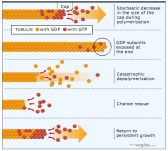Unit Three Exam
1/159
There's no tags or description
Looks like no tags are added yet.
Name | Mastery | Learn | Test | Matching | Spaced |
|---|
No study sessions yet.
160 Terms
What is the cytoskeleton?
A complex network of interlinking filaments and tubules that extend throughout the cytoplasm of a cell
Is the cytoplasm, rigid or dynamic?
The cytoplasm is dynamic, allowing for movement and restructuring of the cytoskeleton.
Before improvements in microscopy, what was the original thought of the inside of a cell?
The inside of the cell was just a gelatinous environment that organelles floated around in.
What is the first function of the cytoskeleton?
The spatial organization of the contents of a cell, such as dividing chromosomes during cell division, and organelle trafficking.
What is the second function of the cytoskeleton?
Connects the components of the cell both physically and biochemically to the external environment such as structural support and mechanical stress.
What is the third function of the cytoskeleton?
Generating coordinated forces that enable the cell to move and/or change shape through processes like cell migration and chemotaxis.
What is the best analogy of the cytoskeleton and why?
Legos because many copies of a few key pieces fit together to form larger objects, it can assemble and disassemble flexibly to adapt to the needs of the cell.

Specifically when talking about actin, what can it form?
Many different structures.
Is formation of the cytoskeleton spontaneous?
Yes through all functions except sometimes.

There are three main types of polymers: Microfilaments, Microtubules, and Intermediate Filaments. What are microfilaments made of?
Actin filaments, composed mainly of actin protein. which forms highly organized NETWORKS of polymers and actin binding proteisn to local signally acitivity.

There are three main types of polymers: Microfilaments, Microtubules, and Intermediate Filaments. Are microfilaments polarized?
Yes, microfilaments have a plus (barbed) end and a minus (pointed) end, which allows for directional growth.

There are three main types of polymers: Microfilaments, Microtubules, and Intermediate Filaments. What are microfilaments motor proteins?
Myosins, which facilitate movement along actin filaments.

There are three main types of polymers: Microfilaments, Microtubules, and Intermediate Filaments. What are microfilament persistence length also called stiffness?
It is about medium stiffness or rigidity, indicating resistance to deformation under stress. (13.5µm)

There are three main types of polymers: Microfilaments, Microtubules, and Intermediate Filaments. What are microtubules made of?
composed of tubulin, which is a protein that forms long, hollow tubes essential for cell shape and transport.

In a microtubulin what is the dynamic instability?
Dynamic instability refers to the rapid growth and shrinkage of microtubules, allowing for cellular adaptability and function such as mitosis and intracellular transport.

There are three main types of polymers: Microfilaments, Microtubules, and Intermediate Filaments. Where are microtubules organized?
Central centers which are know as MTOC’s(Microtubule Organizing Centers) in the cell,

There are three main types of polymers: Microfilaments, Microtubules, and Intermediate Filaments. Are microtubules polarized?
Yes, microtubules have directionality with a plus (growing) end and a minus (shrinking) end, allowing for specific cellular interactions and transport.

There are three main types of polymers: Microfilaments, Microtubules, and Intermediate Filaments. What are microtubules motor proteins made of?
kinesins and dyneins, are made of protein subunits that facilitate movement along the microtubule structure, enabling intracellular transport and cellular movement.

What two subunits make up microtubules?
composed of alpha and beta tubulin dimers that polymerize to form the hollow tube structure.

There are three main types of polymers: Microfilaments, Microtubules, and Intermediate Filaments. What are intermediate filaments made of?
A family of related proteins that function mainly in strengthening of the cytoskeleton.

There are three main types of polymers: Microfilaments, Microtubules, and Intermediate Filaments. What are microtubules persistance length?
5000µm

There are three main types of polymers: Microfilaments, Microtubules, and Intermediate Filaments. What are intermediate filaments persistance length?
0.5 µm

There are three main types of polymers: Microfilaments, Microtubules, and Intermediate Filaments. What do intermediate filaments respond to?
Mechanical stress and tension, providing structural support.

There are three main types of polymers: Microfilaments, Microtubules, and Intermediate Filaments. Are intermediate filaments polarized?
No, they are non-polarized

There are three main types of polymers: Microfilaments, Microtubules, and Intermediate Filaments. What are intermediate filaments motor proteins?
Cannot support motor proteins, about 70 different proteins makeup the intermediate filaments.
What is the most flexible cytoskeleton polymer?
microtubules
What is the least flexible cytoskeleton polymer?
Intermediate filaments
What is a scenario that shows how the cytoskeleton assist in intracellular organizations?
The movement of mitochondria down an axon of a neuron to provide energy for neurotransmission.
The cytoskeleton evolved over time but started where?
In prokaryotes, as a simple structure, allowing for basic cellular functions.
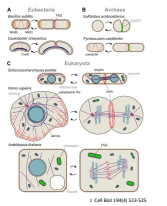
When talking about microfilaments what is the cortex?
The cross-linked, contractile network that makes up the observed membrane of the cell.
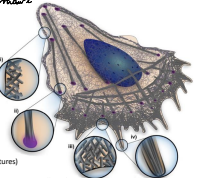
When talking about microfilaments what is the stress fibers?
Structures composed of bundled actin filaments that provide tensile strength to cells and support adherence to the extracellular matrix. They are antiparallel contractile strucutresA
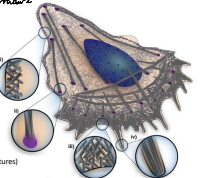
When talking about microfilaments what is the lamellipodia?
A dense thick layer of branched actin filaments that extend from the leading edge of a cell, enabling cell movement and migration. The layer is branches and crosslinked
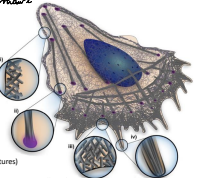
When talking about microfilaments what is the filopodia?
Thin, protrusive structures made of parallel bundle of actin filaments that extend from the leading edge of a cell, facilitating exploration and contact with the environment. The layer is not for strength but for function.
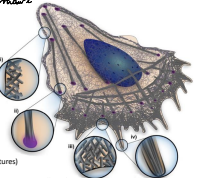
Actin is made of a contractile (spring) and elastic (shock absorber) section. What is the contractile portion?
The region where actin filaments can slide past each other, allowing for muscle contraction and relaxation. The stress fibers and cortex.
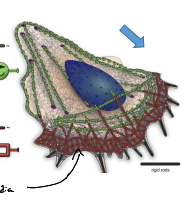
Actin is made of a contractile (spring) and elastic (shock absorber) section. What is the elasitic portion?
The region that provides flexibility and absorbs shock, helping to maintain cell structure and integrity during deformation. The lamelopodia and filopodia are also supported by this portion.
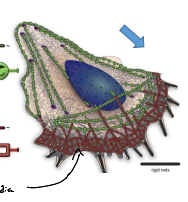
Is ATP required to form microfilaments?
Only for the breakdown of the actin, it is highly conserved and spontaneous in formation

If the concentration of substrate is below the critical condition, then…
filaments shrinks
If the concentration of substrate is above the critical condition, then…
filaments grow and stabilize.
What is critical concentration in microfilament dynamics?
The concentration of subunits at which the filament wil neighter grow nor shrink
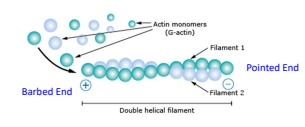
Microfilaments had a positive and negative end, what side does actin preferentially add to?
The positive end.
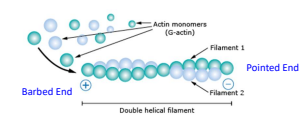
Is there a higher or lower critical concentration at the positive end of a microfilament?
Higher Critical concentration
What is treadmilling when talking about microfilaments dynamics>?
The phenomenon when on end of a filament grows in length while the other end shrinks resulting in a section of filament seemingly “moving” across a stratum or the cytosol
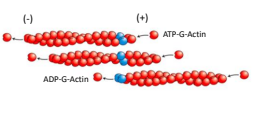
How are Actin Microfilaments formed?
From G-actin monomers. in a spontaneous but controlled mechanism with different models of nucleation events.
Actin microfilaments are highly conserved and spontaneously form, but what is the weird part of actin?
It is an ATPase that can hydrolyze ATP to ADP, influencing filament dynamics. However, the ATP does not need to be hydrolyzed for the actin to form and polymerize into filaments; therefore, actin can also exist in an ATP-bound state. The only requirement is that the ATP is bound to the actin.
What is the difference between G-actin versus F-actin?
G-actin refers to the monomeric form of actin, while F-actin refers to the filamentous polymerized form of actin. G-actin can polymerize to form F-actin under the right conditions.
How many actin must come together in order for spontaneous formation of microfilaments to occur with actin?
Three actin molecules.
What is the first step of Tip-Nucleation model?
Formins function as dimers and interact with the terminal actin subunits.
What is the second step of Tip-Nucleation model?
Each Formin monomer binds to a Profilin unit attached to a G-actin monomer.
What is the Formin in Tip-Nucleation Model?
A protein that facilitates the nucleation and elongation of actin filaments by forming dimers and interacting with G-actin. It has filamentous arms that grab actin/profilin, promoting polymerization by acting as a hoop that the actin passes through while building microfilaments.
What is the Profilin in Tip-Nucleation Model?
A small actin binding protein that blocks spontaneous binding of actin.
What is an APC-C Dimer?
A protein complex responsible for recruiting and bring formin to an actin protein rich area to build a microfilament.
Is the ATP or ADP. the older version of actin?
ADP is the older version of actin, representing the form that is less polymerized compared to ATP-bound actin.
What is the first step of Arp2/3 Mediated Model?
Arp2/3 Complex binds to sides or (-) end of actin filaments
What is the second step of Arp2/3 Mediated Model?
Nucleation Promotion Factors deliver G-actin subunits to the anchored complex
What is the third step of Arp2/3 Mediated Model?
G-actin monomers are added to (+) end of growing filaments
What is the Arp2/3 complex in Nucleation?
A protein complex that acts as the anchor for a branched actin microfilaments
Since Arp2/3 complexes can not move like Formin, what does this cause?
That the branches can not be any longer that the length that the protein Arp2/3 can reach.Q
What is the name of the branched networks of actin architecture?
Lamellipodia
What is the name of the parallel filaments bundles of actin architecture?
filopodia
What is the name of the antiparallel filament bundles of actin architecture?
Stress fibers
What is the name of the cross-linked networks of actin architecture?
Actin cortex
What is the function of lamellipodia?
Cell movement and shape changes
How do lamellipodia cause cell movement?
The network generates force when assembled at the cell surfae by Arp2/3 complexes and NPFs.
What part of the cell typically is the lamellipodia found?
the leading edge of the the cell during movement
Nucleation Promoting Factors are made of multiple regions, what is the WH domain?
The regulation and localization region of the nucleation promoting factors involved in actin polymerization.
Nucleation Promoting Factors are made of multiple regions, what is the WH2 domain?
The actin binding area which acts almost as a storage space for Apr2/3 to use to grab and build with actin.
Nucleation Promoting Factors are made of multiple regions, what is the Proline rich domain?
The region that enhances the interaction with actin and other proteins involved in the regulation of actin dynamics.
Nucleation Promoting Factors are made of multiple regions, what is the CA domain?
The region that aids in the activation and stabilization of actin nucleation complexes, facilitating efficient actin polymerization.
To build lamellipodia, what is needed to begin the branch?
A primer is needed which is a short actin filament that recruits Arp2/3 to existing microfilaments
What is the purpose of capping proteins on the ends of branched actin groups in lamellipodia?
To bind tothe end of actin filaments to prevent further expansionA
What happens if capping proteins are not present?
Actin filaments would continue to grow uncontrollably, disrupting the regulation of lamellipodia formation and structure. This causes the formation of parallel actin bundles known as filopodia instead.
What is a filapodia?
A longer filamet that projects from the cell surface, composed of tightly packed actin filaments, primarily formed when branching is inhibited. Limited force is produced due to the parallel arrangement of actin filaments.
How do filapodia form?
When capping proteins are not present, formin binds after the recruitment by APC-C dimer, to actin and causes parallel actin bundles.
What is cross linking in filopodia?
actin cross-linking proteins, such as fascin, that bind adjacent actin filaments together to form rigid, parallel bundles. These protein linkages provide the mechanical strength and stability required for filopodia to extend from the cell membrane, enabling cellular processes like migration, invasion, and cell-cell communication
What are Ena/VASP proteins?
What are known as anti-capping proteins that prevent capping proteins from binding and causing increased growth.
If crosslinking proteins like fascin, ⍺-Actinin, or fimbrin are not present then filapodia…
will fall and not be strong.
Other forms of cross linking molecules in actin are ions, what does Ca2+ do?
Blocks polymerization
Other forms of cross linking molecules in actin are ions, what does Mg2+ do?
Promotes Polymerization
What are anti parallel actin bundles?
Also known as stress fibers which are aligned in opposite directions and provide tensile strength within cells.
What protein is unique to stress fibers?
Myosin motors which act as active springs for the contractile unit
In a cross linked network like a cortex the actin filaments are connected by cross linker proteins to form networks, but are NOT.
nucleated by Arp2/3
True or False: In the cortex, crosslinking proteins plays no role in nucleation or assembly, identifying quality is distance between filaments linked together which cause different angels to form depending on the different size of cross link proteins being used.
True
What does crosslinked actin networks (CLANs) adjust to an cause?
Outside stress is applied and waches increased elasticity
What is ADF/Cofilin Induced Disassembly?
a process where the proteins ADF (Actin Depolymerizing Factor) and Cofilin bind to ADP-actin filaments, promoting their disassembly and facilitating turnover in actin networks.
What is ADF/cofilin?
A protein that binds to ADP actin and causes a rotational conformational change that promotes depolymerization of actin filaments.
In a Low ADF/Cofilin concentration is an actin filament more or less likely to break?
More likely to break due to the tensile stress put on a single point.
In a high ADF/Cofilin concentration is an actin filament more or less likely to break?
Less likely due to the increases distribution of the tensile stress which causes the actin filament to be able to bend.
What are three products that results from Actin Network Disassemblyin Low ADF/Cofilin concentration?
Nucleated growth, Nucleated exchange and Recycling, and Profilin ATP-actin.
What are three products that results from Actin Network Disassemblyin High ADF/Cofilin concentration?
bundling and Rod Formation, Actin interacting proteins, Growth from the positive end and branched network formation.
other than severing actin itself what can ADF/Cofilin induced disassembly cause?
Debranching where the cofilin causes the disassociation of the Arp2/3 complex.
What affect can myosin have on disassembly?
The directed motion of mysosin can induce filament buckling and eventually breakage when one end of the myofilament moves faster than the other.
What is the make up of the cell cortex like?
It is unbranched byt overlapping leading to some density
Bacteria and viruses exploit the actin cytoskeleton to enhance their spread from cell to cell. What is an invadopodia?
A tiny footlike protrusion that enables highly metastatic cancer cells to invade neighboring tissues.
When thinking about neurodegenerative disorders what is one affect that the cytoskeleton of cells could play a role in?
Cofilin rods.aggregates were spatially associated with neuritic plaques. The researcher conclude that eh generation of coffilin rods/aggregates marks a sequence of events that correlates with the development of tau pathology and AD independent of patient age.
True or false: Actin assembly and disassembly is an ongoing dynamic process that build cytoskeletal structures in the cell and also reuse actin and associated proteins to constantly rebuild and remodel the actin cytoplasm.
true
In the cytoskeleton there is microtubulin. When it was first being researched, what chemical was used to breakdown microtubulin to observe it?
Colchicine
What did Richard Weisenberg do?
He took tubulin protein and using reversible assembly in a container with all necessary nutrients, proteins and Calcium chelators. He manufactured microtubules in vitro after the addition of GTP.
The energy source of actin is ATP, what is the energy source of microtubules?
GTP
What is dynamic instability?
refers to the rapid oscillation of microtubules between phases of growth and shrinkage. This behavior is crucial for cellular processes such as mitosis and cell motility.
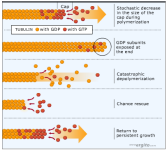
What is the first step described of dynamic instability of microtubules?
Stochastic decrease in the size of the cap during polymerization.
